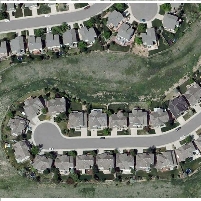End of the Road for Cul-de-Sacs
Monday, May 18, 2009

Concerns over safety made the cul-de-sac popular among suburbanites in the 20th century, but these days a different kind of safety issue is leading communities to do away with dead-end neighborhood streets.
Cul-de-sacs were first built in New Jersey in the 1920s, but it was during the post-World War II construction boom that this feature of suburban planning really took off. By the mid-1950s cul-de-sacs were in communities all across the United States. Developers loved the unusual streets because it allowed them to fit more houses into oddly shaped tracts, while parents appreciated the extra benefits that came with buying a home on a cul-de-sac. With no cross-street to connect, cul-de-sacs reduced traffic, caused drivers to slow down, and discouraged criminals, who tend to prefer multiple escape routes, from coming into an area.
But in Virginia state officials are requiring new developments to have all streets connect with other roadways, meaning cul-de-sacs are forbidden. The move was prompted by concerns that cul-de-sacs make it harder for emergency vehicles, like fire trucks, to reach a scene quickly, or turnaround easily if too many vehicles clog the dead end.
-Noel Brinkerhoff
A Symbol of Suburban Life is Losing Its Cache (by Garrett Morrison, NewJerseyNewsroom.com)
In Va., Vision of Suburbia at a Crossroads (by Eric M. Weiss, Washington Post)
Cul-de-Sacs: Suburban Dream or Dead End? (by John Nielsen, National Public Radio)
- Top Stories
- Unusual News
- Where is the Money Going?
- Controversies
- U.S. and the World
- Appointments and Resignations
- Latest News
- Trump to Stop Deportations If…
- Trump Denounces World Series
- What If China Invaded the United States?
- Donald Trump Has a Mental Health Problem and It Has a Name
- Trump Goes on Renaming Frenzy






Comments